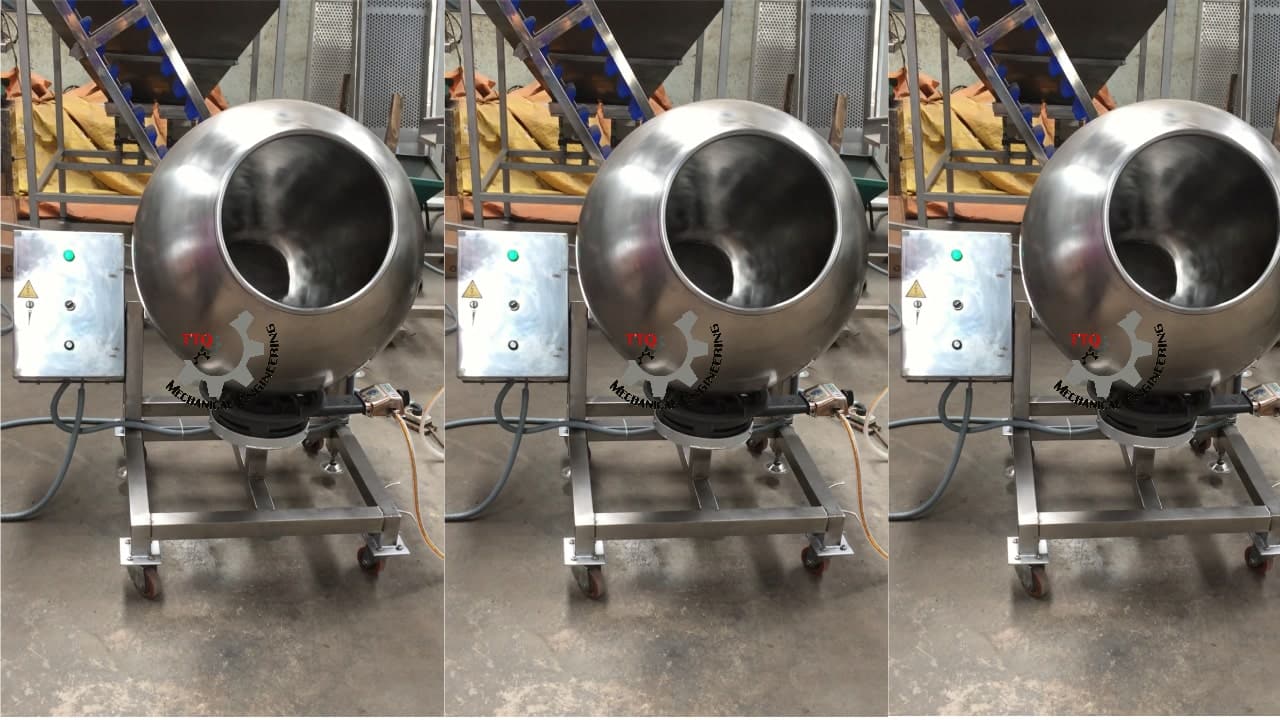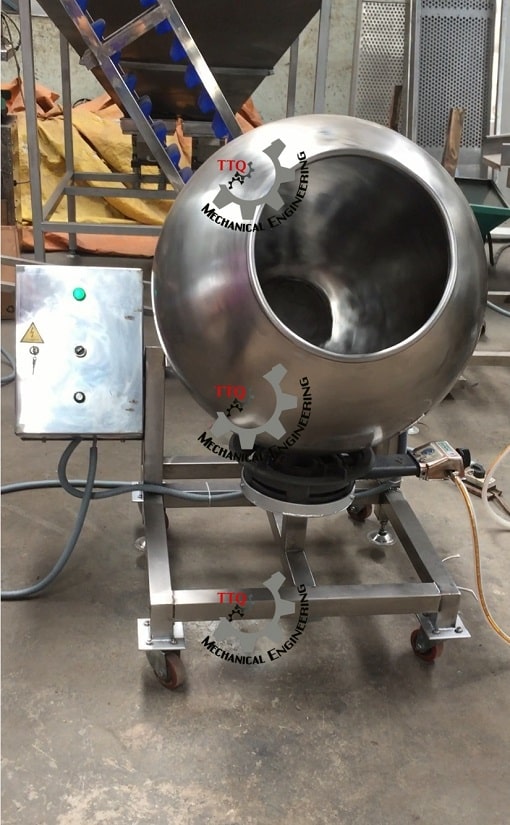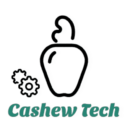
TTQ Co. Ltd.
Sugar Coating Machine | Machine for Sugar Coating | Coated Cashew
A sugar coating machine is a specialized piece of equipment used in the food industry for applying a thin layer of sugar or other powdery coatings onto various types of confectionery or food products. The machine is designed to evenly distribute and adhere the coating to the surface of the product, providing a glossy and attractive appearance.
Here are some key features and components commonly found in sugar coating machines:
The sugar coating machine typically consists of a rotating drum or pan where the coating process takes place. The drum is usually made of stainless steel and is perforated to allow for proper airflow and distribution of the coating material.
The coating system includes mechanisms for applying the coating material to the product. This can be done through various methods, such as spraying, atomizing, or using a sugar pump to evenly disperse the coating onto the products as they rotate inside the drum.
Sugar coating machines a includes a heating system to help melt the coating material or maintain it in a liquid state for better application. Heat is provided by a burner beneath the drum. This burner runs on gas.

Sugar coating machines often feature variable speed control to adjust the rotation speed of the drum or pan. This allows for different coating thicknesses and optimal processing conditions based on the specific requirements of the product being coated.
The control panel provides operators with the ability to monitor and adjust various parameters, such as temperature, rotation speed, and spraying intensity. It allows for precise control over the coating process and ensures consistent results.
Sugar coating machines are commonly used in the production of confectionery products like chocolates, candies, nuts, and pharmaceutical tablets or pills. They offer a reliable and efficient solution for achieving uniform and visually appealing coatings while minimizing waste and ensuring product quality.
When operating a sugar coating machine, it is important to follow the manufacturer’s instructions and guidelines for optimal performance, cleaning, and maintenance. Proper cleaning and regular inspection of the machine’s components are essential to prevent cross-contamination, maintain hygiene standards, and prolong the machine’s lifespan.
Overall, sugar coating machines play a crucial role in the food industry by adding an attractive finish to various products, enhancing their appeal, and providing a delightful sensory experience for consumers.
Which machine is used for sugar coating?
A sugar coating machine or a sugar coater is a machine specifically developed for sugar coating in the food business. It is a specialized piece of equipment used to cover confectionery and food goods with a thin and even layer of sugar or other powdered coatings.
What materials are used for sugar coating?
Different materials can be utilized to generate a range of effects and flavors while sugar coating. Here are some common sugar coating compounds used in the food industry:
Sugar: Granulated or powdered sugar is the most often used sugar coating ingredient. It can add a sweet and crunchy layer to confectionery items such as candies, chocolates, cookies, and pastries. Granulated sugar has a coarser or sparkling texture, whereas powdered sugar has a smoother and softer covering.
Fondant is a sort of sugar paste comprised of sugar, water, and occasionally glucose or corn syrup. It has a flexible texture and is frequently used to create smooth, glossy coatings on cakes, pastries, and biscuits. Fondant can be draped over the object or utilized to make complex decorations.
Chocolate is another popular material for covering a variety of culinary products. It imparts a rich, decadent flavor and can be used as a thin shell or a thicker coating. Depending on the desired taste and look, different types of chocolate, such as dark, milk, or white, can be utilized.
Glazes and Syrups: For a glossy finish and extra flavor, several glazes and syrups can be used for sugar coating. Simple syrup (sugar dissolved in water), honey, corn syrup, and flavored syrups are examples of these. They're frequently used to cover fruits, pastries, and baked items.
Confectioner's Glaze: Shellac, often known as confectioner's glaze, is a natural resin extracted from the lac beetle. It dissolves in alcohol and forms a clear and durable covering. Confectioner's glaze is frequently used to seal and shine sweets, nuts, and other confectionery goods.
Sanding sugar is a coarser-grained sugar with bigger crystals than standard granulated sugar. It comes in a range of hues and is widely used for decoration. Sanding sugar gives baked products, cookies, and candies glitter and texture.
Sprinkles & Decorations: In addition to sugar-based coatings, sugar-coated products can be enhanced with a variety of sprinkles, nonpareils, jimmies, colored sugars, and other decorative elements. These provide visual intrigue, texture, and a splash of color.
What is the principle of sugar coating?
What is the principle of sugar coating is of putting a thin and even layer of sugar or other coating ingredients to the surface of a food product. The coating process is often guided by the following general principles:
Preparation of the Substrate: The food product to be coated is prepared by making sure it is clean, dry, and free of pollutants or excess moisture. This aids the coating material's adhesion to the surface.
Coating Material Application: The coating material is applied on the food product, such as sugar, fondant, chocolate, or other materials. This can be accomplished by a variety of processes, such as spraying, tumbling, dipping, or enrobing. The purpose is to produce uniform and even coating material distribution across the product's surface.
Adhesion and Binding: The coating substance must adhere to the food product's surface. Factors such as the stickiness of the coating material itself, as well as the presence of moisture or other binding agents on the product's surface, frequently make this easier. Adhesion aids in the retention of the coating and the formation of a cohesive layer.
Drying or Solidification: After applying the coating material, it must dry or solidify to form a stable coating layer. This can be accomplished through a variety of means, including air drying, chilling, and the use of temperature-controlled settings. The drying process aids in the setting and retention of the coating material's shape and texture.
Coating machine
Machine for sugar coating
Coating machines
Sugar coating machines
Stainless steel coating pan
Pharmaceutical coating process
Keywords: coating machine, coating, coating machine, coating, sugar coating, sugar, machines, coating machines, sugar-coating, sugarcoating machine, sugar coater, coating tablets, number call, coating products, video view, supplier request, manufacturers show, pan, coating pan, small, tablets, conventional coating, sugar coating pan, sugar coating process, coating machine, coating.
Sugar coating machine for sale, Sugar coating machine price, Sugar coating machine in india, Sugar coating machine manufacturers

